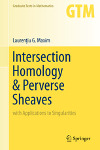- About MAA
- Membership
- MAA Publications
- Periodicals
- Blogs
- MAA Book Series
- MAA Press (an imprint of the AMS)
- MAA Notes
- MAA Reviews
- Mathematical Communication
- Information for Libraries
- Author Resources
- Advertise with MAA
- Meetings
- Competitions
- Programs
- Communities
- MAA Sections
- SIGMAA
- MAA Connect
- Students
- MAA Awards
- Awards Booklets
- Writing Awards
- Teaching Awards
- Service Awards
- Research Awards
- Lecture Awards
- Putnam Competition Individual and Team Winners
- D. E. Shaw Group AMC 8 Awards & Certificates
- Maryam Mirzakhani AMC 10 A Awards & Certificates
- Two Sigma AMC 10 B Awards & Certificates
- Jane Street AMC 12 A Awards & Certificates
- Akamai AMC 12 B Awards & Certificates
- High School Teachers
- News
You are here
Intersection Homology & Perverse Sheaves with Applications to Singularities

Publisher:
Springer
Publication Date:
2019
Number of Pages:
285
Format:
Hardcover
Series:
Graduate Texts in Mathematics 281
Price:
74.99
ISBN:
978-3-030-27643-0
Category:
Textbook
[Reviewed by , on ]
Franco Rota
07/4/2020
Goresky and MacPherson introduced intersection homology in 1974, to recover some of the classical results and properties of manifolds (like Poincaré duality, Lefschetz type theorems and Hodge theory for complex manifolds) in the context of singular spaces. The crucial intuition of intersection homology is that these results hold once one considers cycles that meet the singular locus with a controlled lack of transversality. This book does a wonderful job of motivating the origin of the subject and illustrating its faceted role in modern-day mathematics.
The first few chapters explore the geometric implications of the definition of intersection homology and build intuition by providing a rich variety of examples and illustrations. With this background in mind, the author moves to the sheaf theoretic definition of intersection homology suggested by Deligne, and provides a clear and concise introduction to the main technical aspects of sheaves and derived categories, which culminates in the Beilinson-Bernstein-Deligne-Gabber decomposition theorem and its applications.
Throughout the book, and most prominently in the chapters on hypersurface singularities, the exposition is grounded in concrete and insightful examples drawn from a wide range of areas of study. An exception to this is the last chapter, which is a brief, and more technical, introduction to M. Saito's theory of mixed Hodge modules. In the same spirit of concreteness that permeates the book, the Epilogue provides a roundup of the lively and vast areas of research where intersection homology and perverse sheaves play a role and points interested readers to useful references.
The book chapters are mostly self-contained, the proofs are neat and the narration transitions seamlessly from one topic to the next. Sometimes, proofs of the main results are omitted for brevity, while their applications are emphasized. The exercises present in every section are a good way for readers to keep their understanding in check throughout the book; this makes the text into a great first introduction to the topic.
Readers should have some background knowledge in topology, and some familiarity with sheaf theory and category theory. The book originated from a series of lectures, and it is well suited as a textbook for a graduate class on these topics.
In summary, this is a good textbook to prepare a student to delve into the current literature, and also a good reference for a researcher. A mathematician whose research or interest has come in contact with these topics would also find this a stimulating read on the subject.
Franco Rota is an Assistant Professor at Rutgers University. His research areas include algebraic geometry and derived categories. His email is rota@math.rutgers.edu.
See the publisher's web page.
- Log in to post comments




